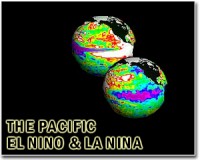| . |  |
. |
Canberra, Australia (SPX) May 28, 2010 The climate of the Pacific region will undergo significant changes as atmospheric temperatures rise but scientists can not yet identify the influence it will have on the El Nino-Southern Oscillation (ENSO) weather phenomenon. This is a central finding of an international science review by the World Climate Research Program's Climate Variability and Predictability Pacific Panel, published in Nature Geoscience. The Panel convened in Australia at the Greenhouse 2009 climate change conference to consider new research that could build an understanding of changes in the behaviour of ENSO. ENSO is a naturally occurring phenomenon causing climate variability that originates in the tropical Pacific region and influences ecosystems, agriculture, freshwater supplies, hurricanes and other severe weather events worldwide. "There is an increasing body of evidence pointing to significant changes in Pacific Ocean climate as a consequence of global warming," says co-author, Dr Wenju Cai from CSIRO's Wealth from Oceans Flagship. "What we are attempting to clarify is how those changes will enhance or moderate ENSO and, in Australia's case, deliver stronger or weaker El Nino events which would have vastly different implications," he says. Dr Cai and Dr Scott Power, a Bureau of Meteorology scientist at the Centre for Australian Weather and Climate Research were members of the international team of authors of the Nature Geoscience paper; The impact of global warming on the tropical Pacific Ocean and El Nino. Dr Power says ENSO will continue to have a profound influence on climate around the world over the coming century " This report shows, however, that determining how ENSO will change in response to further global warming and what this means for Australia and our Pacific neighbours is a real challenge." The report concludes that rising global temperatures will bring change to the Pacific region in several ways: tropical easterly trade winds are expected to weaken; surface ocean temperatures are expected to warm fastest near the equator; and, the thin water layer separating the ocean's upper surface layer from its calm deep water below (the thermocline) is expected to become narrower and less deep. "During El Nino events, weakening trade winds slosh warm water to the eastern equatorial Pacific and this reduces the east-west ocean temperature difference across the Pacific Ocean," Dr Power says. "This reduction further weakens the winds to produce a reinforcing feedback loop that makes El Nino grow." On the other hand, as the ocean temperature increases along the equator, enhanced cloud cover will curtail the growth of El Nino." Global warming causes changes in ocean temperatures, ocean currents, winds and clouds and these changes alter the strength of these feedbacks. This could change the character of ENSO and the impact that ENSO has on countries like Australia." Dr Cai says quantifying changes to the many competing feedbacks underlying ENSO is very difficult. "Clouds in particular are such a difficult feature to represent in models and cloud feedbacks remain the largest uncertainty in the global climate models." "Year-to-year ENSO variability is controlled by this delicate balance of such amplifying and damping feedbacks. "While the possibility of large changes in ENSO cannot be ruled out, research conducted to date does not yet enable us to say precisely whether ENSO variability will be enhanced or moderated, or how the frequency of events will change," Dr Cai says. The authors suggest further research directions and coordination efforts that would continue to improve science's understanding of, and ability to accurately model ENSO, and enable researchers to predict the level of ENSO activity in the short-term (10 to 30 years). The paper's lead author is Dr Matt Collins from the Met Office Hadley Centre in the UK.
Share This Article With Planet Earth
Related Links Wealth from Oceans Flagship CSIRO Marine and Atmospheric Research El Nino, La Nina and an Ocean called Pacifica
 El Nino phenomenon to die out by mid-year
El Nino phenomenon to die out by mid-yearGeneva (AFP) March 30, 2010 Weather experts said Tuesday that El Nino, the weather anomaly that wrecks havoc around the Pacific and east Africa, has peaked and would disappear by mid-year. "The most likely outcome by mid-year 2010 is for the El Nino event to have decayed and near-neutral conditions to be re-established across the tropical Pacific," said the World Meteorological Organisation expert Rupa Koumar Kolli. ... read more |
|
| The content herein, unless otherwise known to be public domain, are Copyright 1995-2010 - SpaceDaily. AFP and UPI Wire Stories are copyright Agence France-Presse and United Press International. ESA Portal Reports are copyright European Space Agency. All NASA sourced material is public domain. Additional copyrights may apply in whole or part to other bona fide parties. Advertising does not imply endorsement,agreement or approval of any opinions, statements or information provided by SpaceDaily on any Web page published or hosted by SpaceDaily. Privacy Statement |